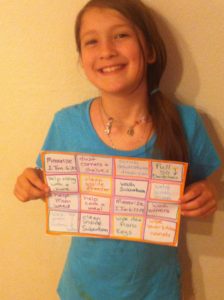If you are like me, you have made some bad decisions with money as an adult. Wouldn’t it be nice to help make sure our children do not make the same mistakes? Here are some of things I have learned when it comes to teaching our children about money.
You may have heard of the K.I.S.S. principle (Keep It Simple Silly). Remember the goal here is to teach our children basic financial principles so when they become adults they will make fewer mistakes and have many more positive outcomes. Keep in mind this takes time, practice and patience.
I have found there are three primary age groups when you can teach your child these basic money principles. With these age ranges, please note that these are suggestions. You as the parent choose what is appropriate to teach your child when.
Stage 1 (Recommended Ages 4 to 6) At this stage, whenever your child does a simple chore that you have asked him or her to do, pay them right then and there. Have them put the money in a clear container so they can see their progress. You do not have to pay them very much for them to feel like they have earned a million dollars. Consider starting with a dollar or even a quarter or two. The primary objective is to begin teach your child to understand the principle of when you work you get paid. Then everyone once and while take the money out and count it. Have them begin to see how money grows.
Keep in mind that throughout all of these stages they do not have to get paid for everything they do. Sometimes, they need to do a task or a chore to build character that is beyond earning a dollar.
Stage 2 (Recommend Ages 6-1 4) This is where it is encouraged to step up the responsibility and the opportunity for your children to earn more money. Consider creating a commission chore board where your child has multiple chores they can do to earn money.
4) This is where it is encouraged to step up the responsibility and the opportunity for your children to earn more money. Consider creating a commission chore board where your child has multiple chores they can do to earn money.
What we do at our house is whatever age our child is at they have an opportunity to earn up to double their age in commissions. We create a simple chore board that shows them what they have to accomplish (see picture below). For every chore they complete they get a dollar. We then pay them once per week based on what has been completed. Then each of our children divide their money into three separate envelopes (giving, saving and spending).
The primary objective is to build the habit of always giving, saving and spending. I do recommend setting a maximum amount they can earn from you in a given month (just in case you have an overachiever – and if you, do see if they can make money doing odd jobs for other people).
Be sure to be consistent with paying your children. One of our daughters one Sunday (we do ours on Sunday after church) kept asking, “Dad when are we going to get paid for our chores?” We also shake it up with each new chore board and try to find other chores they can do. Also, if you are really in a tight financial spot, get creative. One idea to consider is to give them tickets to use for extra fun time or one less chore to do. At the end of the day the same lesson is learned.
Stage 3 (Recommend Ages: 14-18) The next stage is to have your child open a savings and a checking account. Instead of your child putting their savings in an envelope, now have them build the habit of putting their savings into an account at the bank.
Having a checking account in place will begin the learning process of depositing money, balancing their checking account and making sure they do not overdraw their account. Once they have mastered that, you may want to consider them getting a debit card. Very few checks are written these days. And it is much easier to teach and monitor debit card use before they are out of the house.
If they do not have a job yet, add up how much you spend on them on a given month for various budget items and give them that amount of money to manage. Let them know that you usually spend that amount of money for XYZ for them in a given month. They can use the money however they see fit. However, if they spend all the money before the month is over, they cannot get any more money from mom and dad until next month. No exceptions. Just like touching a hot stove. Once you have done it once, you will never do it again!
Other Ideas to Teach Children
- Show them your budget. I will always remember the first time I showed our oldest our budget for the first time. I believe he was 13 years old. As we were going down the list of our mortgage and the utilities portion of our budget he was shocked to see how much things in the “real world” actually cost. So when we go to the utilities this is where I explained, “Now do you see why we say shut the door?!”
- Cars.All of our children that are old enough to understand, we have told them we are not paying for their car. If you want your own car you can purchase it with the money you earn working. Some parents will match their child (up to a certain dollar amount). That is totally up to you. Our oldest son at 17 years old purchased his first car all on his own. He did that with the cash he earned from his first job, and also learned how to negotiate to get a better deal.
Kids are hungry to learn how to handle money wisely. Their future and our country’s future will be greatly impacted by how well and how early they learn how to manage money. You can do this. Start today!
What money principles have you taught your children?
What are some of your fondest moments of your children exercising good money habits?

